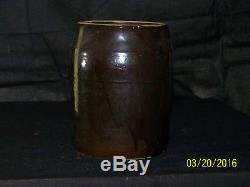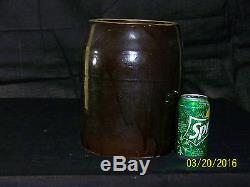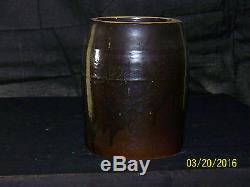
- Index
- Listed By
- Maker
- A P Donnaghho (8)
- A.p. Donaghho (10)
- Adam Caire (7)
- Cowden & Wilcox (16)
- E & L P Norton (8)
- E.w. Farrington (11)
- Fulper (6)
- Hamilton & Jones (23)
- J & E Norton (9)
- Red Wing (171)
- Red Wing Stoneware (7)
- Redwing (10)
- Robinson Ransbottom (18)
- Unknown (233)
- Unkown (6)
- West Troy Pottery (6)
- Western (8)
- Western Stoneware (24)
- Westerwald (8)
- Whites Utica (10)
- ... (4977)
- Material
- Ceramic (10)
- Ceramic & Porcelain (386)
- Ceramic Stoneware (2)
- Ceramic, Stoneware (9)
- Clay (47)
- Clay & Dough (231)
- Clay, Stoneware (2)
- Crock (5)
- Metal (2)
- Pottery (32)
- Stone (53)
- Stone Ware (4)
- Stoneware (942)
- Stoneware / Pottery (2)
- Stoneware Clay (4)
- Stoneware Pottery (41)
- Stoneware, Pottery (2)
- Stownware (3)
- Wax (4)
- Wood (4)
- ... (3791)
- Signed
- Style
- 15 Gallon Crock (7)
- American (9)
- American Primitive (71)
- American Stoneware (8)
- Americana (958)
- Antique (357)
- Art Deco (14)
- Country (144)
- Country Americana (10)
- Crock (27)
- Early Texas Pottery (6)
- Farmhouse (19)
- Folk Art (13)
- French (7)
- Jug (12)
- Naive, Primitive (301)
- Primitive (36)
- Rustic / Primitive (153)
- Stoneware (8)
- Victorian (12)
- ... (3404)
- Type
- Bowl (4)
- Butter Churn (6)
- Butter Churn Crock (5)
- Butter Crock (9)
- Cookie Jar (46)
- Crock (512)
- Crocks (195)
- Jar (10)
- Jars (5)
- Jug (125)
- Jug Bottle (6)
- Kitchen Equipment (39)
- Moonshine Jug (10)
- Pottery (1000)
- Pottery - Stoneware (6)
- Pottery Crock (5)
- Stoneware (24)
- Stoneware Crock (53)
- Stoneware Jug (20)
- Stoneware Pottery (6)
- ... (3490)
Antique c19th Century Americana Brown Glazed Stoneware Crock Jug










Antique c19th Century Americana Brown Glazed Stoneware Clay Jug/Crock. MEASURES: 10 1/2" x 8".
It was usually covered in a. And often decorated using cobalt oxide to produce bright blue decorations. The vernacular term "crocks" is often used to describe this type of pottery. Though the term "crock" is not seen in period documents describing the ware.Additionally, while other types of stoneware were produced in America concurrently with itfor instance, ironstone. And various types of chinain common usage the term "American Stoneware" refers to this specific type of pottery.
American stoneware was fired to a high temperature (about 1200 °C to 1315 °C). Americans began producing salt-glazed stoneware circa 1720 in Philadelphia, Pennsylvania. By the 1770s, the art of salt-glazed stoneware production had spread to many centers throughout the United States, most notably.There the Crolius and Remmey families, two of the most important families in the history of American pottery, would by the turn of the 19th century set the standard for expertly crafted and aesthetically pleasing American stoneware. By 1820, stoneware was being produced in virtually every American urban center, with potters from Baltimore, Maryland, in particular raising the craft to its pinnacle. While salt-glazing is the typical glaze technique seen on American Stoneware, other glaze methods were employed. Vessels were often dipped Albany Slip, a mixture made from a clay peculiar to the Upper Hudson Region of.
And fired, producing a dark brown glaze. Albany Slip was also sometimes used as a glaze to coat the inside surface of salt-glazed ware. While decorated ware was usually adorned using cobalt oxide, decorative techniques such as incising were also used. Flowering plants, birds, or other decoration were cut into the leather-hard clay using a stylus to produce detailed recessed images on the vessels; these were usually also highlighted in cobalt. Stamped or coggled designs were sometimes impressed into the leather-hard clay, as well.
Potters occasionally substituted manganese or iron oxide for cobalt oxide to produce brown, instead of blue, decorations on the pottery. In the last half of the 19th century, potters in New England and New York state began producing stoneware with elaborate figural designs such as deer, dogs, birds, houses, people, historical scenes and other fanciful motifs including elephants and bathing beauties. A significant percentage of American Stoneware was signed using maker's marks and, much more rarely, incised signatures. Many pieces can be attributed to particular makers based on the cobalt decoration, clay body, form, etc.
The gallon capacity of the vessels was often denoted using numeral stamps or incised or cobalt oxide numbers or hash marks applied in freehand. American Stoneware was valued as not only a durable, decorative houseware but as a safer alternative to. Produced in America before and during its production there. This earthenware, commonly referred to today as American Redware, was often produced by the same potters making American Stoneware.
Stoneware manufacturers of note include. Captain James Morgan, Warne & Letts.Henry Remmey, David Parr, Maulden Perine. Samuel Bell, Solomon Bell, J. The item "Antique c19th Century Americana Brown Glazed Stoneware Crock Jug" is in sale since Thursday, May 25, 2017.
This item is in the category "Antiques\Decorative Arts\Ceramics & Porcelain\Jugs". The seller is "1kul57" and is located in Laurel, Maryland.This item can be shipped to North, South, or Latin America, all countries in Europe, all countries in continental Asia, Australia, South africa, New Zealand.
- Maker: Unknown
- Type: Crock/Jug Stoneware
- Primary Material: Ceramic & Porcelain / Clay
- Age: 1850-1899
- Color: Brown
- Original/Reproduction: Original
- Style: Americana
- Country/Region of Origin: United States

